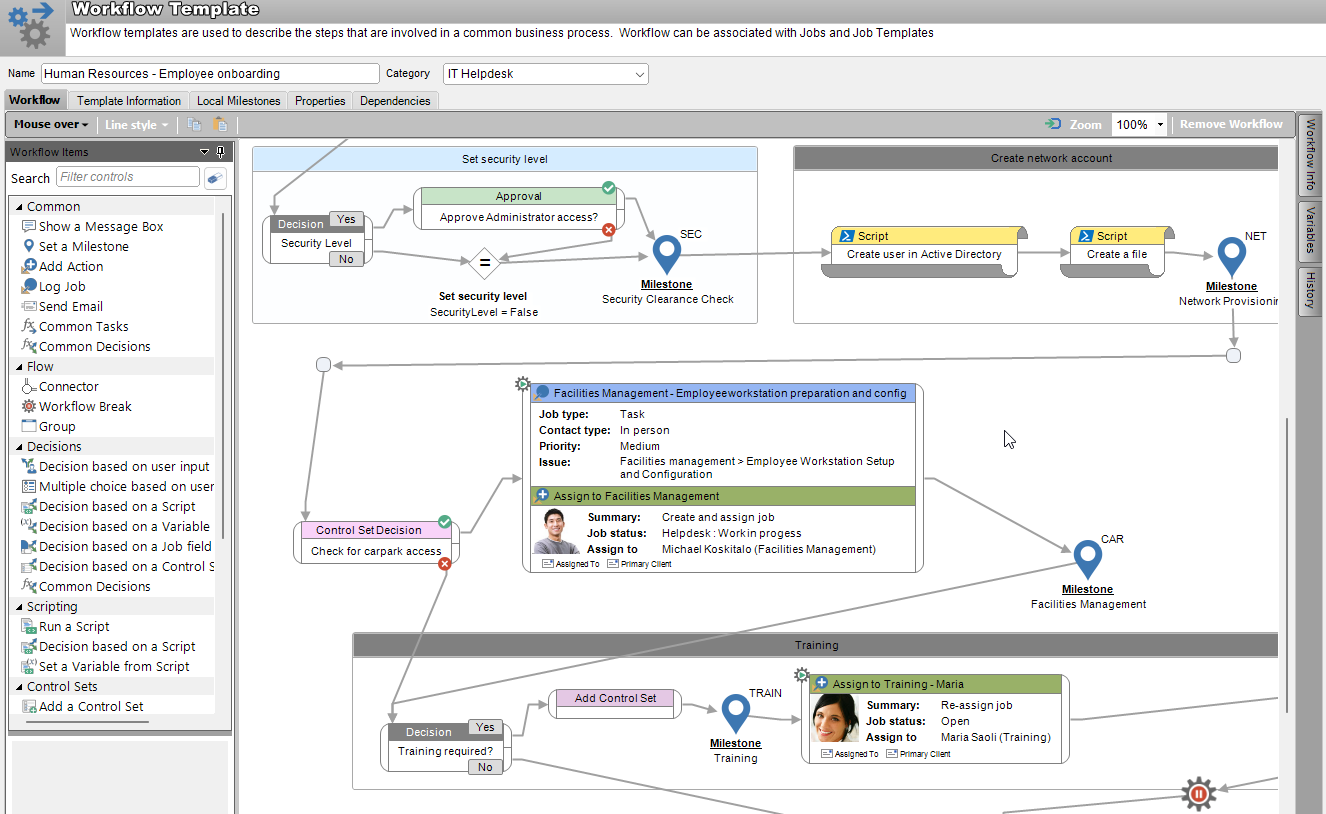Overview
All businesses have a set of tasks that they perform in their day-to-day operations to achieve core business functions. Naturally, different tasks require a different set of steps in order to achieve the task, and employees of the business are trained in the various ways to perform various duties.
HelpMaster features a flexible and powerful workflow designer that allows you to map an existing business process as a series of workflow steps which can then be followed by staff members interacting with the job. Designing and building workflow is achieved by using an intuitive drag-and-drop interface where you simply drag the appropriate workflow object onto the workflow designer, set the relevant properties, and then connect it to the next step. No coding, no developer required - simply configure objects.
There are many workflow objects to use, with more objects being added to the product in future releases.

Once the workflow has been created it can be applied to new, or existing jobs, and saved into a Job Template, or as a Workflow Template for re-use.
When a job/ticket is logged that contains workflow, staff members are able to interact with these jobs according to the defined workflow. This makes working with jobs much more efficient, consistent and meaningful. See Working with workflow
Workflow use-cases
Workflow can be used in many different business contexts. If you are logging jobs/tickets with HelpMaster for any business unit, consider building a corresponding process for that ticket type. Some examples include:
Information Technology Related
- Incident Management
- Software development bug tracking
- Customer service and support
- Change Management
Human Resources Related
- New Employee onboarding / exit procedures
- Asset provisioning
- Security clearance and vetting
- Accident and injury case management and investigation
Facilities Management Related
- Schedule and service equipment
- Safety checks
- Accident reporting
General Business
- Task management
- Operational processes
- …any day-to-day task that a business does that has a defined process
Use the workflow designer to map business processes
A workflow definition is a template that specifies the steps, markers, milestones, decisions, assignment and communication and other logic that is used to complete the business process. Workflow processes are visually represented via a series of connected workflow objects and connectors.
This usually involves making decisions along the way, and taking a different course of events based on the answer to those decisions.HelpMaster allows a business to model these steps by means of a workflow designer.The workflow model in HelpMaster is simply a series of Action Templates that have been joined together to describe a business function. At various points within the workflow, “Decision Points” can be inserted. Depending on the outcome of the decision, the flow can be re-directed along different paths. Moreover, the flow can be re-directed back to any previous step within the workflow to create a loop, or repetition of a step.
Workflow is a key-feature of HelpMaster. The concepts, objects, entities and principles of workflow touches virtually every other feature/component of HelpMaster. Understanding workflow and building processes is the way to unlock the real power of HelpMaster.
Example Workflow
The following workflow associated with a Job Template describes a simple process for starting a new employee at a company. Once the job is logged, the workflow become available to use.

Pre-made templates vs Ad-hoc Workflow
Workflow definitions can be built and stored as a Workflow Templates, imported into Job Templates, or built on-the-fly, or ad-hoc within an existing job. Workflow can be build piece-by-piece, or you can copy some or all of an existing workflow diagram from an existing job or job template.
See Also
Use Application Security Roles to govern access and use of workflow
Feedback
Was this page helpful?
Glad to hear it! Please tell us how we can improve.
Sorry to hear that. Please tell us how we can improve.